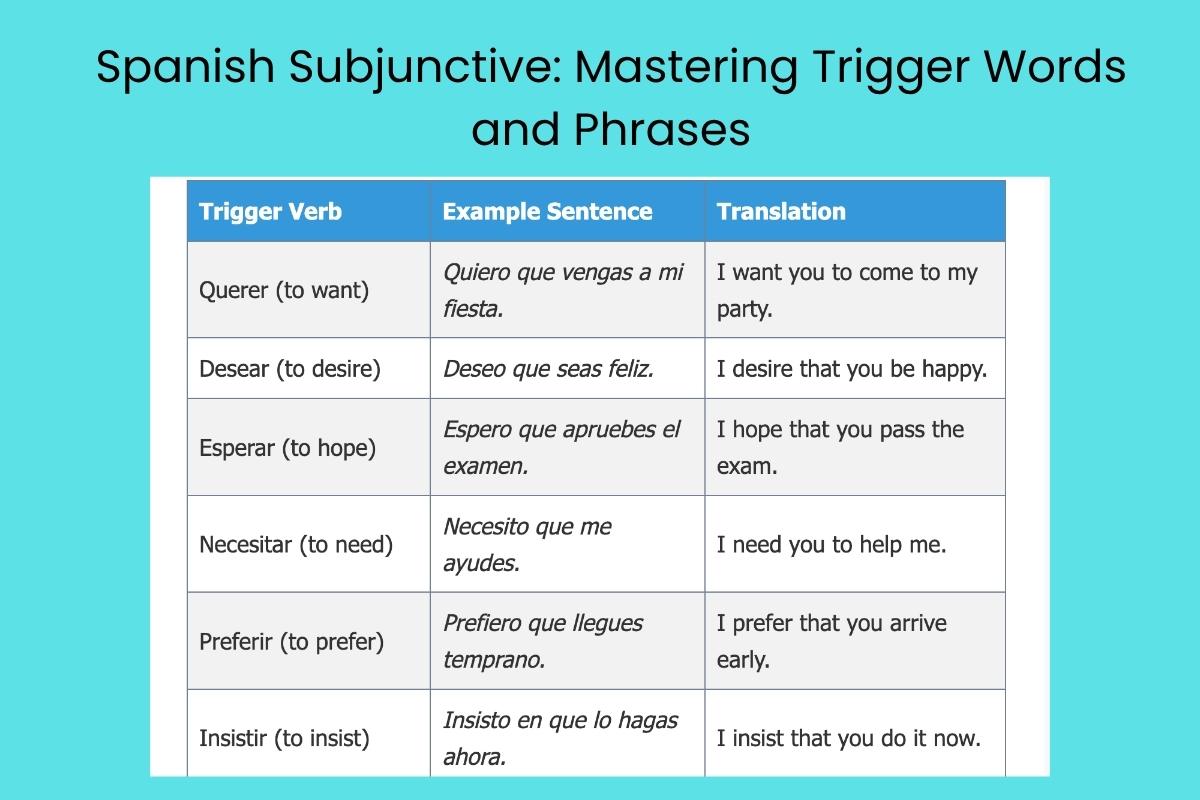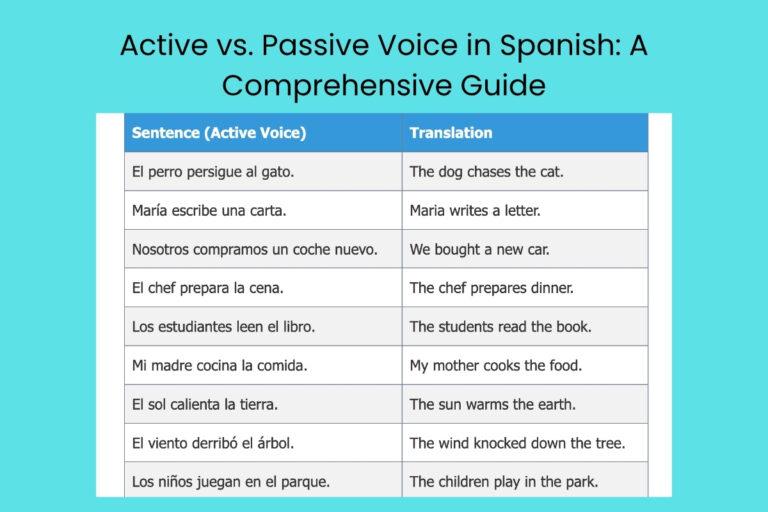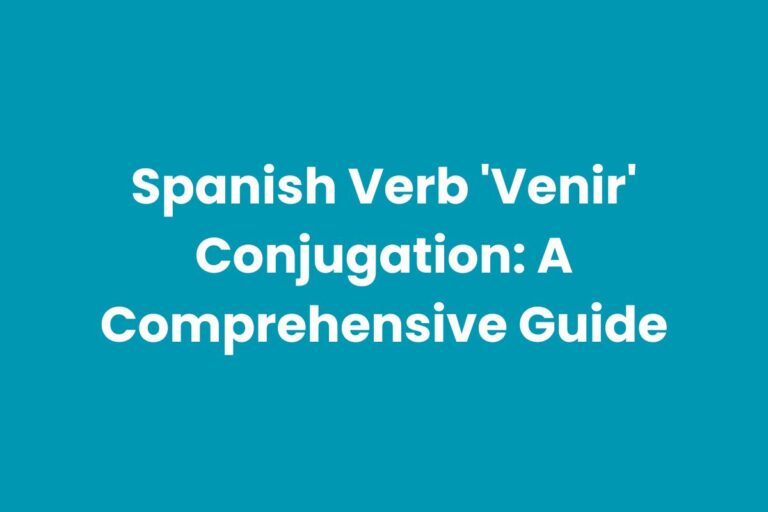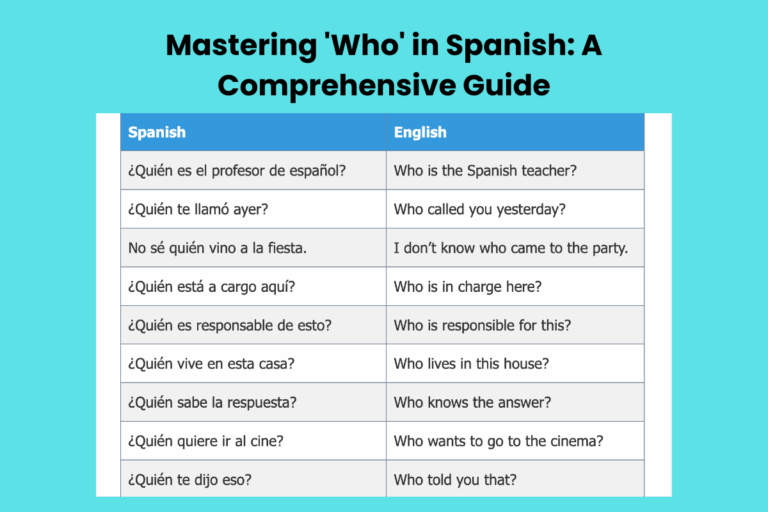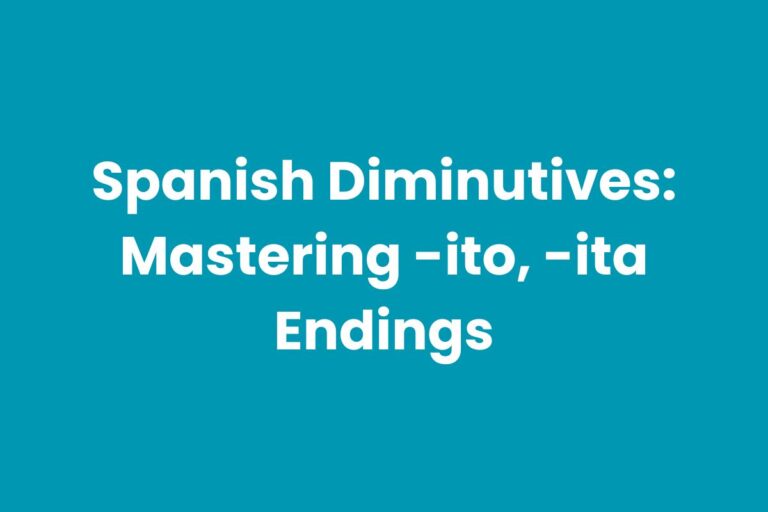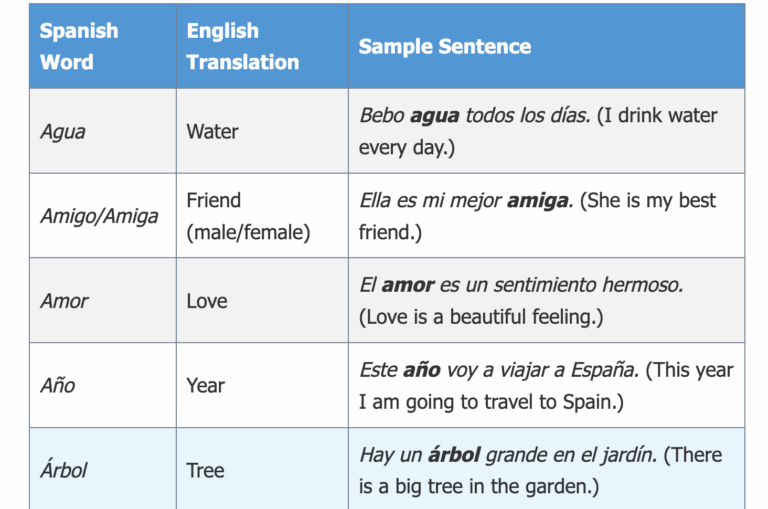Spanish Subjunctive: Mastering Trigger Words and Phrases
The Spanish subjunctive mood is a grammatical concept that often poses a challenge for learners. It expresses subjectivity, doubt, desire, emotion, or uncertainty, contrasting with the indicative mood, which expresses factual statements.
Mastery of the subjunctive requires understanding the specific words and phrases that trigger its use. This article provides a comprehensive guide to Spanish subjunctive triggers, offering detailed explanations, numerous examples, and practical exercises to help you confidently navigate this essential aspect of Spanish grammar.
Whether you’re a beginner or an advanced student, this guide will enhance your understanding and use of the Spanish subjunctive.
Table of Contents
- Introduction
- Definition of the Spanish Subjunctive
- Structural Breakdown
- Types and Categories of Subjunctive Triggers
- Examples of Subjunctive Triggers
- Usage Rules
- Common Mistakes
- Practice Exercises
- Advanced Topics
- FAQ
- Conclusion
Definition of the Spanish Subjunctive
The Spanish subjunctive is a verb mood used to express subjective, hypothetical, or emotional statements. It differs from the indicative mood, which conveys objective facts and certainties. The subjunctive doesn’t describe what is, but rather what someone wants, doubts, fears, or hopes. It’s a crucial element in expressing nuanced meanings and complex ideas in Spanish.
In essence, the subjunctive reflects a speaker’s perspective or attitude towards an action or state. It commonly appears in subordinate clauses, dependent on a main clause that sets the context for subjectivity.
Understanding the subjunctive is essential for achieving fluency and accuracy in Spanish, allowing you to convey a wider range of emotions and intentions.
Structural Breakdown
The subjunctive is typically found in subordinate clauses introduced by the conjunction que (that). The basic structure involves a main clause expressing a trigger (e.g., a wish, doubt, or emotion) followed by que and then the subordinate clause with the verb in the subjunctive mood. The subject of the main clause often differs from the subject of the subordinate clause, which is a common indicator of subjunctive use.
For example:
Quiero que vengas. (I want you to come.)
Here, quiero (I want) is the main clause, and que vengas (that you come) is the subordinate clause. The verb vengas is in the subjunctive mood because the main clause expresses a desire. The structure emphasizes the dependence of the subjunctive clause on the trigger in the main clause.
Types and Categories of Subjunctive Triggers
Subjunctive triggers can be categorized into several main groups, each associated with specific types of expressions. These categories include wishes and desires, emotions, impersonal expressions, doubt and denial, influence and recommendation, conjunctions, and adjectival clauses.
Understanding these categories helps to predict when the subjunctive mood should be used.
Wishes and Desires
Verbs and expressions that convey wishes, desires, hopes, and commands often trigger the subjunctive. Common examples include querer (to want), desear (to desire), esperar (to hope), necesitar (to need), and insistir (to insist). These expressions indicate a subjective desire or preference, leading to the use of the subjunctive in the subordinate clause.
For example:
Espero que tengas un buen día. (I hope you have a good day.)
Emotions
Expressions of emotions, such as joy, sadness, fear, surprise, and anger, frequently trigger the subjunctive. Verbs like alegrarse (to be happy), temer (to fear), sentir (to regret), and sorprenderse (to be surprised) are common triggers. These emotions reflect a subjective reaction, necessitating the subjunctive in the dependent clause.
For example:
Me alegro de que estés aquí. (I’m glad that you are here.)
Impersonal Expressions
Impersonal expressions that convey opinions, evaluations, or possibilities often require the subjunctive. These expressions typically start with es (it is) followed by an adjective or adverb. Common examples include es importante (it’s important), es necesario (it’s necessary), es posible (it’s possible), and es mejor (it’s better).
For example:
Es importante que estudies. (It’s important that you study.)
Doubt, Denial, and Uncertainty
Verbs and expressions that express doubt, denial, or uncertainty trigger the subjunctive. This includes verbs like dudar (to doubt), negar (to deny), no creer (to not believe), and expressions like es dudoso (it’s doubtful) and no es cierto (it’s not certain). These expressions indicate a lack of certainty, prompting the use of the subjunctive.
For example:
Dudo que venga. (I doubt that he/she comes.)
Influence and Recommendation
Verbs of influence, recommendation, and command also trigger the subjunctive. These verbs include recomendar (to recommend), sugerir (to suggest), aconsejar (to advise), pedir (to ask), and prohibir (to prohibit). These verbs imply an attempt to influence someone’s actions, leading to the subjunctive in the subordinate clause.
For example:
Recomiendo que leas este libro. (I recommend that you read this book.)
Conjunctions
Certain conjunctions always trigger the subjunctive, regardless of the main clause. These conjunctions typically express purpose, condition, time, or concession. Common examples include para que (so that), a menos que (unless), antes de que (before), en caso de que (in case), sin que (without), and aunque (although, when expressing a hypothetical situation).
For example:
Lo hago para que estés contento. (I do it so that you are happy.)
Adjectival Clauses
In adjectival clauses, the subjunctive is used when the antecedent (the noun the clause modifies) is indefinite, uncertain, or nonexistent. If the antecedent is definite and known, the indicative mood is used.
The use of the subjunctive emphasizes the hypothetical or uncertain nature of the noun being described.
For example:
Busco un libro que sea interesante. (I am looking for a book that is interesting – not a specific book.)
Busco el libro que es interesante. (I am looking for the book that is interesting – a specific book.)
Examples of Subjunctive Triggers
The following tables provide extensive examples of subjunctive triggers organized by category. Each example illustrates the use of the subjunctive in a sentence, demonstrating how different triggers lead to the subjunctive mood.
Wishes and Desires Examples
This table shows examples of how verbs expressing wishes and desires trigger the subjunctive. Notice the use of “que” to introduce the subjunctive clause.
| Trigger Verb | Example Sentence | Translation |
|---|---|---|
| Querer (to want) | Quiero que vengas a mi fiesta. | I want you to come to my party. |
| Desear (to desire) | Deseo que seas feliz. | I desire that you be happy. |
| Esperar (to hope) | Espero que apruebes el examen. | I hope that you pass the exam. |
| Necesitar (to need) | Necesito que me ayudes. | I need you to help me. |
| Preferir (to prefer) | Prefiero que llegues temprano. | I prefer that you arrive early. |
| Insistir (to insist) | Insisto en que lo hagas ahora. | I insist that you do it now. |
| Ojalá (I hope/wish – Arabic origin) | Ojalá que llueva café en el campo. | I wish it would rain coffee in the countryside. |
| Anhelar (to yearn) | Anhelo que encuentres la paz. | I yearn that you find peace. |
| Aspirar (to aspire) | Aspiro a que seamos amigos. | I aspire for us to be friends. |
| Rogar (to beg) | Te ruego que me perdones. | I beg you to forgive me. |
| Suplicar (to plead) | Suplico que me escuches. | I plead that you listen to me. |
| Mandar (to order) | Mando que te calles. | I order you to be quiet. |
| Exigir (to demand) | Exijo que me digas la verdad. | I demand that you tell me the truth. |
| Quisiera (I would like) | Quisiera que me acompañaras. | I would like you to accompany me. |
| Desearía (I would wish) | Desearía que estuvieras aquí. | I would wish that you were here. |
| Ambicionar (to covet) | Ambiciono que tengamos éxito. | I covet that we have success. |
| Implorar (to implore) | Imploro que me des otra oportunidad. | I implore you to give me another chance. |
| Pretender (to intend) | Pretendo que lo entiendas. | I intend that you understand it. |
| Buscar (to look for) | Busco un novio que me ame. | I’m looking for a boyfriend who loves me. |
| Exhortar (to urge) | Exhorto que todos participen. | I urge everyone to participate. |
| Animar (to encourage) | Animo que sigas intentando. | I encourage you to keep trying. |
Emotions Examples
This table illustrates how expressions of emotion trigger the subjunctive mood. Note the use of prepositions like “de” before “que” in some cases.
| Trigger Verb | Example Sentence | Translation |
|---|---|---|
| Alegrarse (to be happy) | Me alegro de que estés bien. | I’m glad that you are well. |
| Temer (to fear) | Temo que llegues tarde. | I fear that you will arrive late. |
| Sentir (to regret) | Siento que no puedas venir. | I regret that you can’t come. |
| Sorprenderse (to be surprised) | Me sorprende que sepas eso. | I’m surprised that you know that. |
| Estar contento (to be happy) | Estoy contento de que hayas venido. | I’m happy that you came. |
| Estar triste (to be sad) | Estoy triste de que te vayas. | I’m sad that you are leaving. |
| Enfadarse (to get angry) | Me enfada que no me escuches. | It angers me that you don’t listen to me. |
| Preocuparse (to worry) | Me preocupa que no estés aquí. | I’m worried that you are not here. |
| Asustarse (to get scared) | Me asusta que haya fantasmas. | It scares me that there are ghosts. |
| Lamentar (to regret deeply) | Lamento que hayas sufrido. | I deeply regret that you have suffered. |
| Apenarse (to be saddened) | Me apena que estés enfermo. | I am saddened that you are sick. |
| Indignarse (to be outraged) | Me indigna que hagan eso. | It outrages me that they do that. |
| Molestar (to bother) | Me molesta que fumes aquí. | It bothers me that you smoke here. |
| Maravillarse (to be amazed) | Me maravillo que hables español. | I’m amazed that you speak Spanish. |
| Admirar (to admire) | Admiro que seas tan valiente. | I admire that you are so brave. |
| Detestar (to detest) | Detesto que llegues tarde. | I detest that you arrive late. |
| Odiar (to hate) | Odio que me mientas. | I hate that you lie to me. |
| Fastidiar (to annoy) | Me fastidia que no me hagas caso. | It annoys me that you don’t pay attention to me. |
| Enorgullecerse (to be proud) | Me enorgullezco de que seas mi hijo. | I’m proud that you are my son. |
| Complacer (to please) | Me complace que estés aquí. | It pleases me that you are here. |
| Avergonzarse (to be ashamed) | Me avergüenzo de que hayas hecho eso. | I’m ashamed that you have done that. |
Impersonal Expressions Examples
This table provides examples of impersonal expressions that trigger the subjunctive. These expressions often start with “es” followed by an adjective.
| Impersonal Expression | Example Sentence | Translation |
|---|---|---|
| Es importante (it’s important) | Es importante que estudies. | It’s important that you study. |
| Es necesario (it’s necessary) | Es necesario que llegues a tiempo. | It’s necessary that you arrive on time. |
| Es posible (it’s possible) | Es posible que llueva mañana. | It’s possible that it will rain tomorrow. |
| Es mejor (it’s better) | Es mejor que te quedes en casa. | It’s better that you stay at home. |
| Es urgente (it’s urgent) | Es urgente que lo hagas ahora. | It’s urgent that you do it now. |
| Es fundamental (it’s fundamental) | Es fundamental que sigas las reglas. | It’s fundamental that you follow the rules. |
| Es esencial (it’s essential) | Es esencial que duermas bien. | It’s essential that you sleep well. |
| Es aconsejable (it’s advisable) | Es aconsejable que hagas ejercicio. | It’s advisable that you exercise. |
| Es preferible (it’s preferable) | Es preferible que vayas solo. | It’s preferable that you go alone. |
| Es imprescindible (it’s indispensable) | Es imprescindible que tengas pasaporte. | It’s indispensable that you have a passport. |
| Es raro (it’s rare) | Es raro que nieve en verano. | It’s rare that it snows in summer. |
| Es sorprendente (it’s surprising) | Es sorprendente que sepas todo. | It’s surprising that you know everything. |
| Es una lástima (it’s a pity) | Es una lástima que no puedas venir. | It’s a pity that you can’t come. |
| Es dudoso (it’s doubtful) | Es dudoso que gane el partido. | It’s doubtful that he will win the game. |
| Es increíble (it’s incredible) | Es increíble que hayas logrado eso. | It’s incredible that you have achieved that. |
| Es justo (it’s fair) | Es justo que recibas una recompensa. | It’s fair that you receive a reward. |
| Es injusto (it’s unfair) | Es injusto que te culpen. | It’s unfair that they blame you. |
| Es natural (it’s natural) | Es natural que sientas miedo. | It’s natural that you feel fear. |
| Es lógico (it’s logical) | Es lógico que estés cansado. | It’s logical that you are tired. |
| Es conveniente (it’s convenient) | Es conveniente que reserves con tiempo. | It’s convenient that you book in advance. |
Doubt, Denial, and Uncertainty Examples
This table demonstrates how expressions of doubt, denial, and uncertainty trigger the subjunctive mood.
| Trigger Verb | Example Sentence | Translation |
|---|---|---|
| Dudar (to doubt) | Dudo que venga mañana. | I doubt that he/she will come tomorrow. |
| Negar (to deny) | Niego que haya hecho eso. | I deny that I have done that. |
| No creer (to not believe) | No creo que sea verdad. | I don’t believe that it’s true. |
| No estar seguro (to not be sure) | No estoy seguro de que tenga razón. | I’m not sure that he/she is right. |
| Es dudoso (it’s doubtful) | Es dudoso que lo logre. | It’s doubtful that he/she will achieve it. |
| No es cierto (it’s not certain) | No es cierto que sea rico. | It’s not certain that he/she is rich. |
| No pensar (to not think) | No pienso que sea buena idea. | I don’t think it’s a good idea. |
| Poner en duda (to question) | Pongo en duda que sea honesto. | I question that he/she is honest. |
| Desconfiar (to distrust) | Desconfío de que me diga la verdad. | I distrust that he/she is telling me the truth. |
| No imaginar (to not imagine) | No imagino que pueda hacerlo. | I don’t imagine that he/she can do it. |
| No parecer (to not seem) | No parece que esté contento. | It doesn’t seem that he/she is happy. |
| Cuestionar (to question) | Cuestiono que sea posible. | I question that it’s possible. |
| No estar convencido (to not be convinced) | No estoy convencido de que sea la solución. | I’m not convinced that it’s the solution. |
| Ignorar (to ignore) | Ignoro que haya pasado. | I ignore that it has happened. |
| Desconocer (to not know) | Desconozco que exista tal cosa. | I don’t know that such a thing exists. |
| No constar (to not be recorded) | No consta que haya venido. | It’s not recorded that he/she has come. |
| No verificar (to not verify) | No he verificado que sea cierto. | I haven’t verified that it’s true. |
| Discrepar (to disagree) | Discrepo que tenga razón. | I disagree that he/she is right. |
| Refutar (to refute) | Refuto que sea verdad. | I refute that it’s true. |
| Contradecir (to contradict) | Contradigo que haya dicho eso. | I contradict that he/she has said that. |
Usage Rules
The primary rule for using the subjunctive is that it is triggered by specific verbs, expressions, or conjunctions that indicate subjectivity, doubt, emotion, or uncertainty. The subject of the main clause and the subordinate clause should generally be different for the subjunctive to be required.
However, there are exceptions and nuances to these rules.
When there is no change of subject (i.e., the subject of the main clause is the same as the subject of the subordinate clause), the infinitive is often used instead of the subjunctive. For example, instead of saying Quiero que yo vaya (I want that I go), it’s more common to say Quiero ir (I want to go).
The conjunction si (if) never triggers the subjunctive in the present tense. However, si clauses can involve the subjunctive in hypothetical or conditional situations in the past (e.g., Si hubiera sabido, habría venido – If I had known, I would have come).
Common Mistakes
One of the most common mistakes is using the indicative mood after a subjunctive trigger. For example, saying Espero que tienes un buen día (I hope that you have a good day) is incorrect; the correct form is Espero que tengas un buen día. Another common error is using the subjunctive when there is no trigger, especially in simple statements of fact.
Another mistake is forgetting to conjugate the subjunctive verb correctly. The subjunctive conjugations are different from the indicative conjugations, and using the wrong form can lead to confusion.
Finally, using the infinitive when the subjunctive is required, or vice versa, is a frequent error, particularly when dealing with verbs of influence or desire.
Here are some examples of common mistakes and their corrections:
| Incorrect | Correct | Explanation |
|---|---|---|
| Espero que tienes un buen día. | Espero que tengas un buen día. | “Espero que” triggers the subjunctive. |
| Dudo que es verdad. | Dudo que sea verdad. | “Dudo que” triggers the subjunctive. |
| Quiero que tú vas. | Quiero que tú vayas. | “Querer que” requires the subjunctive. |
| Es importante que voy. | Es importante que vaya. | Impersonal expressions like “es importante que” trigger the subjunctive. |
Practice Exercises
Complete the following sentences by conjugating the verb in parentheses into the correct subjunctive form.
- Es importante que (estudiar) ___________ para el examen.
- Dudo que él (decir) ___________ la verdad.
- Quiero que tú (venir) ___________ a mi fiesta.
- Me alegro de que (estar) ___________ aquí.
- Es necesario que nosotros (hacer) ___________ la tarea.
- Temo que (llover) ___________ mañana.
- No creo que ella (saber) ___________ la respuesta.
- Prefiero que tú (llegar) ___________ temprano.
- Es posible que (haber) ___________ un problema.
- Siento que tú no (poder) ___________ venir.
Answer Key:
- estudies
- diga
- vengas
- estés
- hagamos
- llueva
- sepa
- llegues
- haya
- puedas
Exercise 2: Choose the correct form of the verb (indicative or subjunctive) to complete the sentences.
- Sé que él (es/sea) ___________ inteligente.
- No creo que él (es/sea) ___________ inteligente.
- Busco un libro que (tiene/tenga) ___________ información sobre historia.
- Conozco a una persona que (tiene/tenga) ___________ un coche rojo.
- Cuando yo (tengo/tenga) ___________ tiempo, voy a la playa.
- Cuando yo (tenga/tenga) ___________ tiempo libre, iré a la playa.
- Lo hago para que tú (estás/estés) ___________ feliz.
- Aunque (hace/haga) ___________ frío, saldré a caminar.
- Si (tengo/tenga) ___________ dinero, compraré una casa.
- Si (tenía/tuviera) ___________ dinero, compraría una casa.
Answer Key:
- es
- sea
- tenga
- tiene
- tengo
- tenga
- estés
- haga
- tengo
- tuviera
Exercise 3: Translate the following sentences into Spanish, using the subjunctive where necessary.
- I want you to do your homework.
- I doubt that he is telling the truth.
- It’s important that you arrive on time.
- I’m glad that you are here.
- I hope that it doesn’t rain tomorrow.
- Unless you study, you won’t pass.
- I don’t think that she knows the answer.
- I’m looking for a house that has a garden.
- It’s possible that there is a mistake.
- Do it so that they are happy.
Answer Key:
- Quiero que hagas tu tarea.
- Dudo que él esté diciendo la verdad.
- Es importante que llegues a tiempo.
- Me alegro de que estés aquí.
- Espero que no llueva mañana.
- A menos que estudies, no aprobarás.
- No creo que ella sepa la respuesta.
- Busco una casa que tenga un jardín.
- Es posible que haya un error.
- Hazlo para que ellos estén felices.
Advanced Topics
Beyond the basic rules, there are more complex aspects of the subjunctive. For instance, the use of the subjunctive in hypothetical situations, especially with the conjunction si, can be challenging. Mastering the various tenses of the subjunctive, including the imperfect subjunctive and the pluperfect subjunctive, is crucial for expressing past hypothetical scenarios.
Another advanced topic is the use of the subjunctive in formal writing and speech. In certain contexts, the subjunctive can add a level of politeness or formality to your language.
Understanding these nuances requires extensive exposure to the language and careful attention to context.
The sequence of tenses also plays a crucial role in subjunctive usage. The tense of the subjunctive verb in the subordinate clause often depends on the tense of the verb in the main clause.
For instance, if the main verb is in the past tense, the subjunctive verb in the subordinate clause might need to be in the imperfect subjunctive.
FAQ
- What is the difference between the indicative and subjunctive moods?
The indicative mood expresses facts and certainties, while the subjunctive mood expresses subjectivity, doubt, emotion, or uncertainty. The indicative describes what is, while the subjunctive describes what someone wants, doubts, or fears. - When should I use the subjunctive?
Use the subjunctive after specific trigger verbs, expressions, or conjunctions that indicate wishes, emotions, impersonal opinions, doubt, influence, or certain conjunctions. - What are some common subjunctive triggers?
Common triggers include verbs like querer (to want), desear (to desire), dudar (to doubt), expressions like es importante (it’s important), and conjunctions like para que (so that) and a menos que (unless). - Does the conjunction si (if) always trigger the subjunctive?
No, the conjunction si does not trigger the subjunctive in the present tense. However, it can be used with the subjunctive in hypothetical or conditional past situations. - What happens if the subject of the main clause and the subordinate clause is the same?
In this case, the infinitive is often used instead of the subjunctive. For example, Quiero ir (I want to go) instead of Quiero que yo vaya. - How do I conjugate verbs in the subjunctive mood?
Subjunctive conjugations differ from indicative conjugations. The exact conjugations depend on the verb and the tense (present, imperfect, etc.). Consult a verb conjugation chart for specific forms. - What is
What is the most common mistake when using the subjunctive?**
The most common mistake is using the indicative mood after a subjunctive trigger instead of the subjunctive mood. - Are there any exceptions to the subjunctive rules?
Yes, there are exceptions and nuances to the rules. Some expressions may sometimes take the indicative mood depending on the context and the speaker’s intent. - How can I improve my subjunctive usage?
Practice regularly, pay attention to context, and familiarize yourself with common subjunctive triggers. Reading and listening to Spanish content can also help you internalize the correct usage. - Is the subjunctive used in all Spanish-speaking countries?
Yes, the subjunctive is used in all Spanish-speaking countries, but there may be regional variations in usage and frequency.
Conclusion
Mastering the Spanish subjunctive is an ongoing process, but understanding the trigger words and phrases is a crucial step. By familiarizing yourself with the categories of subjunctive triggers—wishes and desires, emotions, impersonal expressions, doubt, influence, conjunctions, and adjectival clauses—you can significantly improve your accuracy and fluency in Spanish.
Regular practice, attention to context, and awareness of common mistakes will further enhance your ability to use the subjunctive confidently and effectively. Keep practicing, and you’ll find that the subjunctive becomes a natural and intuitive part of your Spanish communication.

